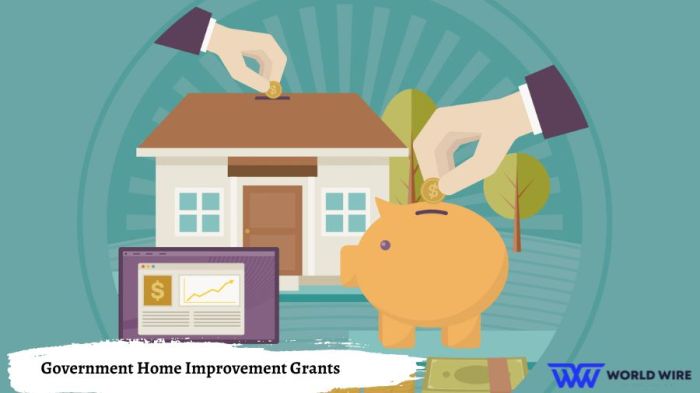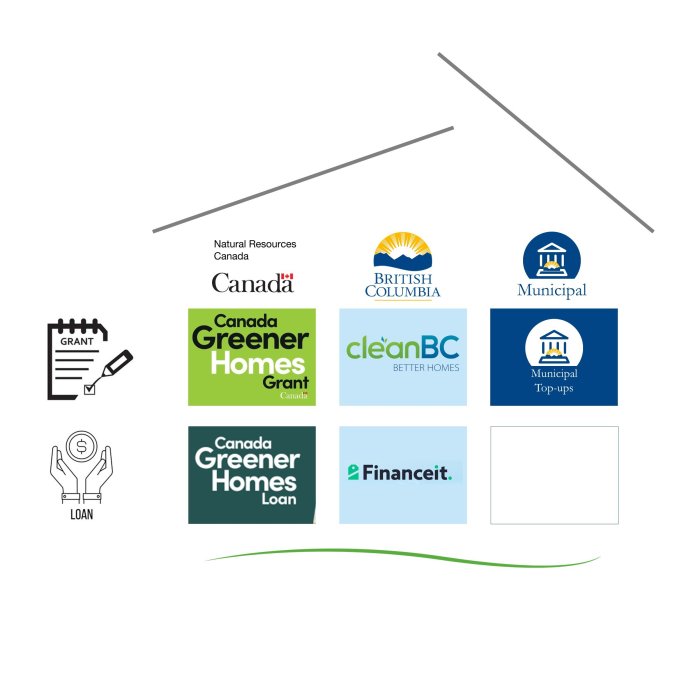Government grants for energy efficient home upgrades offer a fantastic opportunity to improve your home’s comfort and value while reducing your environmental footprint. These grants, often funded at the local, state, or federal level, provide financial assistance for homeowners to make crucial energy-saving improvements. From upgrading insulation and windows to installing high-efficiency HVAC systems, these programs aim to make energy-efficient upgrades more accessible and affordable, leading to long-term cost savings and a more sustainable future.
This guide will explore the eligibility criteria, application processes, and potential benefits of these valuable programs.
Securing a government grant can significantly reduce the upfront cost of energy-efficient home improvements. Understanding the nuances of different grant programs, including eligibility requirements and application procedures, is crucial for successful application. This guide will navigate you through the process, providing a comprehensive overview of available resources and strategies to maximize your chances of securing funding. We will explore various types of eligible upgrades, potential challenges, and the long-term financial and environmental advantages these upgrades provide.
Eligibility Criteria for Government Grants
Securing government grants for energy-efficient home upgrades requires careful consideration of eligibility criteria. These criteria vary depending on the specific program and your location, encompassing income levels, property type, and geographic limitations. Understanding these requirements is crucial for a successful application.
Income Limitations
Many energy-efficient home upgrade grant programs include income restrictions. These limitations aim to prioritize assistance for lower and middle-income households who may struggle to afford energy efficiency improvements. Income thresholds are typically based on household size and are often expressed as a percentage of the area median income (AMI). For example, a program might only accept applications from households earning below 80% of the AMI.
Securing government grants for energy-efficient home upgrades can significantly reduce renovation costs. Many homeowners are choosing to invest these savings in aesthetically pleasing updates, incorporating materials such as those highlighted in this article on Trendy home exterior materials. Ultimately, these grants allow for both improved energy performance and enhanced curb appeal, making home improvements more accessible and attractive.
These percentages can fluctuate between programs and regions. Applicants should carefully review the specific income limits Artikeld in the grant program guidelines. Failure to meet these requirements will result in immediate disqualification.
Property Type and Location Restrictions
Government grants often target specific property types. Some programs may exclusively fund upgrades for single-family homes, while others might extend to multi-family dwellings or even commercial buildings. Location-based restrictions are also common. Grants might be limited to specific counties, cities, or even neighborhoods within a larger region, prioritizing areas with high energy burdens or environmental concerns. For instance, a grant program might focus solely on properties within a designated “energy efficiency zone” or those situated in historically underserved communities.
It is vital to confirm if your property type and location meet the specified criteria.
Regional Variations in Eligibility
Eligibility requirements can differ significantly across various regions and even between different grant programs within the same region. For example, a state-level program might have stricter income requirements than a federally funded initiative. Similarly, programs in rural areas might have different property type limitations compared to those in urban centers. Some programs may prioritize specific types of upgrades, such as solar panel installations or window replacements, while others offer more flexibility.
It is essential to thoroughly research the programs available in your specific location and carefully compare their respective eligibility guidelines.
Summary of Eligibility Criteria for Three Grant Programs
It is important to note that the details provided below are examples and may not reflect current program guidelines. Always refer to the official program guidelines for the most up-to-date information.
| Grant Program | Income Limit | Property Type | Location |
|---|---|---|---|
| Example Program A (State-Level) | 80% of AMI | Single-family homes | County X |
| Example Program B (Federal-Level) | 120% of AMI | Single-family and multi-family homes | Nationwide (with regional variations) |
| Example Program C (Municipal-Level) | 60% of AMI | Single-family homes | City Y |
Types of Energy-Efficient Home Upgrades Covered

Source: world-wire.com
Government grants for energy-efficient home upgrades typically cover a range of improvements designed to reduce energy consumption and lower utility bills. The specific upgrades and funding amounts vary depending on the grant program and your location. This section Artikels common eligible upgrades and provides an overview of typical funding levels.
Many programs prioritize upgrades with the highest potential energy savings, such as insulation and high-efficiency HVAC systems. Funding is often structured as a percentage of the total project cost, up to a predetermined maximum amount. It’s crucial to check the specific guidelines of the grant program you are applying for, as eligibility criteria and funding levels can differ significantly.
Insulation Upgrades
Insulation significantly reduces heat loss in winter and heat gain in summer, leading to substantial energy savings. Government grants often cover insulation for attics, walls, floors, and crawl spaces. Eligible materials may include fiberglass batts, cellulose insulation, spray foam, and rigid foam boards. Funding amounts typically range from a percentage of the cost of materials and installation, often capped at a certain dollar amount per square foot or per project.
For example, a grant might cover 50% of the cost of attic insulation, up to a maximum of $1,000.
Window and Door Replacements
Replacing old, inefficient windows and doors with energy-efficient models can drastically improve a home’s energy performance. Grants often cover the cost of high-performance windows with low-E coatings and energy-efficient doors with improved seals. Funding might cover a percentage of the cost, possibly capped per window or door, or a fixed amount per unit. For instance, a grant may provide $200 per window replaced with an Energy Star certified model.
HVAC System Upgrades
High-efficiency heating, ventilation, and air conditioning (HVAC) systems are a major focus of many energy efficiency grant programs. Grants may cover the replacement of older, less efficient furnaces, air conditioners, and heat pumps with newer models that meet specific energy efficiency standards, such as those with high SEER (Seasonal Energy Efficiency Ratio) ratings. Funding levels vary widely, but could cover a significant portion of the cost of a new system, perhaps up to $5,000 or more, depending on the system’s efficiency and the grant program.
Other Eligible Upgrades
Beyond the major upgrades mentioned above, some grant programs also cover other energy-efficient improvements. These can include:
- Smart thermostats: These programmable thermostats can optimize heating and cooling schedules, leading to energy savings. Funding might be a fixed amount or a percentage of the purchase price.
- LED lighting upgrades: Replacing incandescent and fluorescent bulbs with energy-efficient LED lighting can significantly reduce energy consumption. Grants may offer rebates or discounts on LED bulbs or fixtures.
- Water heating upgrades: High-efficiency tankless water heaters or heat pump water heaters are often eligible for funding. Grants might cover a percentage of the cost or a fixed amount depending on the system’s efficiency.
Cost-Effectiveness of Energy-Efficient Upgrades
The cost-effectiveness of different upgrades varies based on factors such as climate, existing home conditions, and the specific grant program. The table below provides a simplified comparison, illustrating potential savings after considering grant funding. Note that these are illustrative examples and actual savings will vary.
| Upgrade | Estimated Pre-Grant Cost | Estimated Grant Contribution | Estimated Net Cost |
|---|---|---|---|
| Attic Insulation | $2000 | $1000 | $1000 |
| Window Replacement (2 windows) | $3000 | $600 | $2400 |
| High-Efficiency Furnace | $6000 | $2000 | $4000 |
| LED Lighting Upgrade | $500 | $250 | $250 |
Application Process and Required Documentation
Securing a government grant for energy-efficient home upgrades involves a straightforward application process. This section details the steps involved and the necessary documentation to ensure a smooth and successful application. Understanding these requirements will significantly increase your chances of approval.The application process is designed to be user-friendly, but careful preparation is key. Gathering all the necessary documents beforehand will streamline the submission process and prevent delays.
Step-by-Step Application Guide
This guide Artikels the typical steps involved in applying for a government energy efficiency grant. Specific requirements may vary depending on the grant program and your location, so always refer to the official program guidelines.
- Pre-application Check: Before starting the application, verify your eligibility based on the criteria Artikeld in the program guidelines. This includes checking income limits, property ownership requirements, and the types of upgrades covered by the grant.
- Online Application Form Completion: Most grant applications are submitted online. Carefully complete all sections of the application form, providing accurate and complete information. Double-check your entries before submitting.
- Document Upload: Upload all required supporting documents as specified in the application guidelines. Ensure the documents are clear, legible, and in the correct format.
- Application Submission: Once you have completed the form and uploaded all necessary documents, submit your application electronically. You may receive a confirmation email or notification upon successful submission.
- Review and Processing: The application will be reviewed by the grant awarding agency. This process may take several weeks or months, depending on the volume of applications received.
- Notification of Decision: You will be notified of the decision regarding your application. If approved, you will receive instructions on the next steps, including scheduling any necessary inspections or contractor approvals.
Required Documentation Checklist
Preparing the necessary documentation in advance will expedite the application process. This checklist provides a comprehensive overview of the commonly required documents. Always refer to the specific requirements Artikeld in the program guidelines for your chosen grant.
- Proof of Identity: A government-issued photo ID, such as a driver’s license or passport.
- Proof of Income: Recent pay stubs, tax returns, or other documentation verifying your household income.
- Proof of Property Ownership: A copy of your property deed or mortgage statement.
- Property Tax Assessment: A recent property tax assessment showing the assessed value of your home.
- Energy Audit Report (if required): A detailed energy audit report conducted by a qualified energy auditor, outlining energy efficiency improvements needed.
- Contractor Quotes (if required): Detailed quotes from qualified contractors for the proposed energy-efficient upgrades.
- Bank Statements (if required): Bank statements showing sufficient funds for your contribution (if any) to the project costs.
Application Process Flowchart
The following describes a flowchart illustrating the application process. Imagine a flowchart with boxes connected by arrows.Box 1: Start
Securing government grants for energy-efficient home upgrades can significantly reduce renovation costs. Improving insulation, for instance, can lead to substantial savings. Consider how you’ll furnish your newly efficient space; perhaps browsing for pieces like those found at Antique furniture for living room would complement your updated home. Remember, the grant application process might require detailed energy efficiency plans, so meticulous planning is key.
The process begins with the homeowner’s decision to apply for a grant.
Box 2: Eligibility Check
The homeowner verifies their eligibility for the grant program.
Box 3: Gather Documents
The homeowner gathers all the necessary documents listed in the checklist.
Securing government grants for energy-efficient home upgrades can significantly reduce renovation costs. Improving your home’s energy performance often involves exterior changes, and this might inspire you to explore aesthetic enhancements, such as checking out some Modern driveway designs for homes to complement your updated, eco-friendly home. Ultimately, these grants help make sustainable living more accessible and visually appealing.
Box 4: Complete Application
The homeowner completes the online application form accurately and thoroughly.
Box 5: Upload Documents
The homeowner uploads all the required documents to the online application.
Box 6: Submit Application
The homeowner submits the completed application.
Box 7: Application Review
The grant awarding agency reviews the application.
Box 8: Decision Notification
The homeowner receives notification of the application’s approval or denial.
Box 9: Grant Awarded (if approved)
The homeowner receives the grant funds.
Box 10: End
The process concludes with the grant awarded or the application denied.
Finding and Applying for Available Grants
Securing government grants for energy-efficient home upgrades requires proactive research and a clear understanding of available programs. This section details how to locate suitable grants and navigate the application process effectively. Knowing where to look and how to tailor your search is crucial for maximizing your chances of success.Finding suitable grants involves utilizing various online and offline resources.
The internet offers a wealth of information, but it’s essential to prioritize official government websites and established organizations to avoid misinformation. Additionally, local utility companies and community organizations often have partnerships with government programs and can provide valuable guidance.
Securing government grants for energy-efficient home upgrades can significantly reduce your energy bills. After tackling those improvements, you might find yourself with extra time to focus on festive home décor, such as checking out some excellent ideas for Holiday mantel decorating tips to enhance your home’s cozy ambiance. Ultimately, these grants contribute to both financial savings and a more comfortable, attractive living space.
Government Websites and Organizations Offering Energy Efficiency Grants
Several government agencies at the federal, state, and local levels offer energy efficiency grant programs. These programs often have specific eligibility criteria and application processes. It is vital to thoroughly review these requirements before submitting an application. For example, the U.S. Department of Energy (DOE) website offers a wealth of information on federal energy efficiency programs, including links to state-level initiatives.
Many states also have their own energy offices or agencies with dedicated grant programs, and local governments may offer additional incentives. Searching these websites directly will provide the most up-to-date and accurate information.
Searching for Grants Based on Location and Specific Upgrade Needs
The search process should be tailored to your specific location and planned home upgrades. Begin by specifying your location (state, county, city) in your online searches. This will help filter results to show programs available in your area. Next, identify the specific energy-efficient upgrades you plan to implement (e.g., window replacement, insulation, solar panel installation). Many grant programs focus on specific types of upgrades, so aligning your search with your planned improvements will significantly increase your chances of finding a suitable grant.
For example, a homeowner in California planning to install solar panels would search for “California solar panel grants” or visit the California Energy Commission website.
Reputable Websites and Organizations Offering Energy Efficiency Grants
Locating reliable information is crucial for a successful grant application. The following list provides examples of reputable sources, though this is not exhaustive, and you should always verify information independently. Contact information is provided as a starting point; it is advisable to visit the respective websites for the most up-to-date contact details.
Please note that contact information may change. Always verify the most current details on the organization’s official website.
| Organization | Website (Example) | Contact Information (Example) |
|---|---|---|
| U.S. Department of Energy (DOE) | energy.gov | (Contact information varies by program; check the specific program website) |
| Your State’s Energy Office (Example: California Energy Commission) | [State Energy Office Website] | [State Energy Office Contact Information] |
| Local Utility Companies | [Your Local Utility Company Website] | [Your Local Utility Company Contact Information] |
| Non-profit Organizations (e.g., Energy Star) | energystar.gov | (Contact information varies by program; check the specific program website) |
Potential Challenges and Solutions: Government Grants For Energy Efficient Home Upgrades

Source: squarespace-cdn.com
Securing government grants for energy-efficient home upgrades can be a rewarding but sometimes challenging process. Homeowners often encounter obstacles that can hinder their application success or delay the implementation of their energy-saving projects. Understanding these potential challenges and developing proactive strategies to overcome them is crucial for a smooth and successful grant application experience. This section Artikels common difficulties and offers practical solutions to help navigate the process effectively.Navigating the application process for energy efficiency grants requires careful planning and attention to detail.
Many applicants find that the seemingly straightforward process is often complicated by unexpected hurdles. Thorough preparation and a proactive approach are essential to maximize the chances of a successful application. Effective budgeting is also critical to ensure the project aligns with grant funding and avoids unforeseen financial burdens.
Complex Application Forms and Lengthy Processing Times, Government grants for energy efficient home upgrades
Many government grant applications involve extensive paperwork and detailed information requirements. This complexity can be daunting for homeowners unfamiliar with the process, leading to errors or incomplete submissions. Furthermore, processing times for grant applications can vary significantly, often extending beyond anticipated timelines. This delay can cause frustration and impact project planning.
- Problem: Overly complicated application forms leading to errors and incomplete submissions.
- Solution: Allow ample time for completion. Carefully read all instructions. Seek assistance from professionals experienced in grant applications, or contact the grant program administrator for clarification on any unclear points.
- Problem: Long processing times causing project delays and uncertainty.
- Solution: Apply well in advance of your intended project start date. Maintain regular communication with the grant program administrator to track the application’s progress and address any concerns promptly.
Inadequate Budgeting and Unforeseen Costs
Even with careful planning, unforeseen costs can arise during energy-efficient home upgrades. Failing to account for these potential expenses can lead to budget overruns and project delays. Accurate budgeting is crucial to ensure the project remains financially viable and within the scope of the grant funding.
- Problem: Underestimating the total cost of the project, leading to budget overruns.
- Solution: Obtain multiple quotes from reputable contractors. Factor in potential unforeseen expenses (e.g., material price increases, unexpected repairs). Create a detailed budget that includes all anticipated costs, and allocate a contingency fund for unforeseen circumstances.
- Problem: Lack of understanding of grant requirements and limitations.
- Solution: Thoroughly review the grant guidelines to ensure your project meets all eligibility criteria. Contact the grant program administrator to clarify any doubts regarding funding limitations or allowable expenses.
Lack of Awareness of Available Grants and Eligibility Criteria
Homeowners may be unaware of the various energy efficiency grants available or may not meet the specific eligibility criteria for particular programs. This lack of awareness can prevent homeowners from accessing potentially beneficial funding opportunities.
- Problem: Unfamiliarity with available grant programs and their eligibility requirements.
- Solution: Actively research available grant programs at the local, state, and federal levels. Utilize online resources and contact local energy agencies for assistance in identifying suitable grant opportunities. Carefully review the eligibility criteria for each grant before applying.
Long-Term Benefits and Savings
Investing in energy-efficient home upgrades offers significant long-term financial and environmental advantages. These improvements not only reduce your monthly energy bills but also enhance your home’s value and contribute to a more sustainable lifestyle. Government grants significantly reduce the upfront costs, making these upgrades more accessible and accelerating the return on investment.Energy-efficient upgrades translate to substantial savings over time.
Lower energy bills are the most immediate benefit, freeing up your budget for other priorities. Furthermore, a home with updated energy efficiency features is more attractive to potential buyers, increasing its resale value. Beyond the financial aspects, these upgrades contribute to a more comfortable living environment and lessen your environmental footprint.
Reduced Energy Bills and Increased Property Value
The financial benefits of energy-efficient home upgrades are substantial and multifaceted. Reduced energy consumption directly translates into lower monthly utility bills. This saving compounds over time, resulting in significant cost reductions over the lifespan of the upgrades. For example, replacing old windows with energy-efficient models can decrease heating and cooling costs by up to 25%, while upgrading insulation can lead to similar savings.
These cost savings contribute to a faster return on investment, potentially recouping the initial expense within a few years. Moreover, these upgrades enhance your home’s market value, making it a more attractive and desirable property. Appraisers often factor in energy efficiency when assessing a home’s worth, leading to a higher sale price when you decide to sell.
Improved Home Comfort and Environmental Impact
Beyond the financial benefits, energy-efficient upgrades dramatically improve home comfort. Better insulation reduces drafts and temperature fluctuations, leading to a more consistent and comfortable indoor climate. Improved windows and doors minimize noise pollution from outside, creating a quieter and more peaceful living environment. Upgrading to energy-efficient appliances reduces noise and improves overall functionality. Furthermore, these upgrades contribute significantly to environmental sustainability.
By reducing energy consumption, you lessen your carbon footprint and contribute to a cleaner environment. This aligns with global efforts to mitigate climate change and promote sustainable living practices.
Projected Energy Savings Over 10 Years
The following table illustrates projected energy savings over a 10-year period for various energy-efficient upgrades, assuming average energy costs and usage. These figures are estimates and may vary based on individual circumstances, including climate, home size, and energy usage habits. However, they provide a reasonable illustration of the potential cost savings.
| Upgrade | Annual Savings (Estimate) | 10-Year Savings (Estimate) | Example |
|---|---|---|---|
| Window Replacement | $300 | $3000 | Replacing single-pane windows with double- or triple-pane, low-E windows. |
| Insulation Upgrade | $200 | $2000 | Adding attic insulation to R-60 levels and wall insulation to R-20 levels. |
| High-Efficiency HVAC System | $500 | $5000 | Replacing an older furnace and air conditioner with a high-efficiency system (SEER 16+). |
| LED Lighting Upgrade | $100 | $1000 | Replacing incandescent and CFL bulbs with energy-efficient LED bulbs. |
Visual Representation of Energy-Efficient Upgrades
Upgrading your home for energy efficiency doesn’t just save you money; it can also significantly improve the aesthetic appeal of your property. The visual impact of these upgrades varies depending on the specific improvements made, but the overall effect is often one of modernization and enhanced curb appeal. Let’s explore the visual changes associated with some key energy-efficient upgrades.
Energy-Efficient Windows: A Transformation
Replacing outdated windows with energy-efficient models offers a dramatic visual improvement. Older windows, often featuring single-pane glass and decaying wooden frames, can appear worn and drafty. New windows, however, present a clean, modern look. The frame material itself makes a difference; sleek vinyl frames offer a contemporary feel, while wood frames exude a classic charm, often available in various stains and finishes to match your home’s style.
The glass is also a key visual element. Double- or triple-pane windows with low-E coatings are virtually indistinguishable from standard glass at a glance, but their enhanced energy performance is a significant upgrade. Energy ratings, such as U-factors and Solar Heat Gain Coefficients (SHGC), are not visually apparent but contribute to the overall improved look by ensuring clearer, less distorted views and reducing glare.
For instance, a home with old, cloudy single-pane windows replaced with modern, clear double-pane windows will instantly appear brighter and more inviting. The improved seal around the frames eliminates drafts and reduces the appearance of air leaks around the window frames.
Improved Insulation: Enhancing Interior Aesthetics
Insulation, while not directly visible, can indirectly impact the visual appeal of your home’s interior. Different insulation types have varying aesthetic implications. Fiberglass insulation, a common choice, is installed in batts or rolls and is not visible once the walls are closed. Cellulose insulation, often blown into walls and attics, is also unseen but might leave a slightly textured surface if applied improperly.
However, the real visual impact comes from theresults* of better insulation. Consistent temperatures throughout the house eliminate the need for bulky window coverings or space heaters, resulting in a cleaner, more uncluttered interior. Furthermore, improved insulation can reduce condensation on windows, leading to clearer views and a less musty appearance. A home with properly insulated walls will also require less interior lighting, resulting in a brighter, more welcoming atmosphere.
For example, a drafty room with uneven temperatures might necessitate heavier curtains or blankets to maintain comfort, making the room appear smaller and darker. With proper insulation, these can be removed, creating a sense of spaciousness and light.
High-Efficiency HVAC Systems: Subtle Exterior, Significant Interior Impact
The visual impact of a new high-efficiency HVAC system is relatively subtle on the exterior. The new unit might be slightly smaller or more streamlined than the old one, potentially improving the overall curb appeal, but the changes are not usually dramatic. However, the interior changes can be more noticeable. A new, efficient system often operates more quietly, eliminating the distracting noise of older models.
Securing government grants for energy-efficient home upgrades can significantly reduce renovation costs. Improving your home’s insulation and lighting are key areas; for instance, you might consider adding a stunning focal point like one of the beautiful Statement chandeliers while still staying within budget. Remember, energy-efficient upgrades often qualify for these grants, leading to both aesthetic and financial improvements to your property.
Furthermore, the improved air quality and temperature control resulting from a high-efficiency system create a more comfortable and visually appealing interior environment. For instance, an older HVAC system might leave dust and debris circulating in the air, leading to a dingier look and feel. A new high-efficiency system, with improved filtration, will improve air quality, leading to a fresher, cleaner appearance within the home.
The removal of an old, rusty, or visibly damaged outdoor unit can also dramatically improve the visual appeal of the exterior.
End of Discussion
Investing in energy-efficient home upgrades is a smart financial decision with far-reaching benefits. Government grants significantly alleviate the financial burden, making these improvements attainable for a wider range of homeowners. By understanding the eligibility criteria, application process, and available resources, homeowners can successfully navigate the grant application process and reap the rewards of reduced energy bills, increased property value, and a more comfortable, environmentally responsible home.
Taking the initiative to explore these opportunities can lead to substantial long-term savings and contribute to a more sustainable future.
Question & Answer Hub
What happens if my application is denied?
Most grant programs provide feedback explaining the reason for denial. You can often reapply after addressing the issues raised or explore alternative grant programs.
Are there income limits for these grants?
Yes, many programs have income limits to ensure the grants benefit those who need them most. The specific income thresholds vary depending on the program and location.
How long does the application process typically take?
Processing times vary depending on the program and the volume of applications. Allow ample time, and check with the program administrator for estimated timelines.
Can I use the grant money for other home improvements besides energy efficiency?
No, these grants are specifically for energy-efficient upgrades. Using the funds for other purposes would be a violation of the grant agreement.
What if I need help completing the application?
Many programs offer assistance, either through online resources or by contacting program staff directly. Some communities may also offer support services to help with applications.


